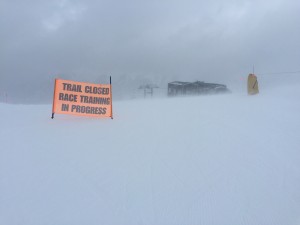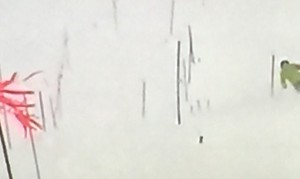This past week I had a new adventure as a first-time participant in the Peak Performance Ski Racing Camp run by top international coach Dave Gregory at Copper Mountain, Colorado. I’ll share the story of how and why I came back to ski racing in mid-life another time, but did not want to delay sharing a few of the cross-over lessons that stood out most as I get back to my life in Chicago.
Not surprisingly, with my attention laser focused on all things agility at the moment, skiing in general, and ski racing in particular, are proving to be a rich field (slope?) for new metaphors and fresh perspectives.
The skiing conditions during the first few weeks of November can be iffy in the mountains. Some years there is barely enough snow to open a few runs (and even then with liberal dustings of artificial snow). This year, aided by El Nino, we had several dumps of fresh snow—not the gentle atmospheric snow, but the piercing, side-ways blowing snow that makes you feel like you have landed on another planet when you get off the lift at the top.
Visibility is Overrated
As we camp participants gathered at the top of our Giant Slalom course a few days into the camp, a dense gust of falling snow swirled around us, obscuring all but the first gate or two of the course. One of Dave’s coaches, Shawn Smith, heartily called out “Visibility is overrated!” and without allowing for a shred of complaint or resistance, shifted to giving us each just the counsel we needed to focus our next run through the gates: “widen your stance,” “quiet upper body,” “steeper edge angles at the top of the turn,” “activate your ankles” and/or “get your legs out from under you.”
When it was my turn to slide into the makeshift starting gate, I realized the lack of visibility might actually be a gift. Of course, I couldn’t articulate much about that gift until I ran the course several times and had collapsed back in my condo, exhausted and exhilarated from a day of learning and stretching my physical limits at 11,000 feet. Here are a few thoughts.
When we can’t see very far ahead we are invited to, and perhaps have no choice but to, be present to our bodies. This means we can only attend to what is really going
on right here in the present moment. And in that present moment, inside our bodies we respond with our whole body, being and heart.
I quickly realized what our coach meant. In reality, visibility (the ability to see) only gives us an illusion of control. The illusion that if we can see farther ahead we will be able to plan and not have to worry about what is happening in the present—our physical sensations, messy emotions, intimacy with ourselves and others, responding to the unexpectedly changing terrain, because we can simply just follow the plan.
Readiness is All
In ski racing, every racer is given the chance to (and virtually required to) inspect the course before taking their first run. Sometimes this involves “slipping the course” in a snowplow and/or slipping sideways through to smooth ruts and widen the brim of snow on the outside of the turns, at others it means skiing along side of the course on the outside. Some people have the ability to memorize the course after one inspection. This is not my strong suit. At best, I hope to remember where the trickiest turns and ice patches are. But every racer knows that by the time it comes to your run, the information you gathered during your inspection may well be old news. While the gates will be in the same place, a new rut or ice patch has developed where there wasn’t one before. Or you may become engulfed in a snow squall or wind gust in the midst of your run that no one can plan for. The good news is that when you are prepared, when you enter the starting gate with strength, flexibility, balance, and a reasonable level of skill and tactics, you only need to see as far as the next gate so that you can set up the arc of your next turn, sometimes while simultaneously recovering from a less than perfect turn on the previous gate.
Action is only possible in the present moment.
—Christian Noss
In life and in our organizations we sometimes can’t even see as far ahead as the next gate, let alone know what lies around the next turn. We can, and often do, inspect the terrain and go ahead and make our plans, but we lock in on those plans at our peril. As soon as the plan becomes an invitation to become comfortable, to abandon our whole person experience in the present moment, we lose our ability to effectively respond to the unexpected and unplanned, and to learn continuously. We also lose our ability to expand our confidence and competence in our capacity to be effective when we can’t see around the next gate.
For me on the race course, this means inspecting the course, setting my intention (with a little help from my coaches), then trusting my readiness and ability to respond in the moment. It also means knowing that falling (we call it crashing in ski racing) is not the end of the world (more on that in a future post).



Powerful on so many levels!! Thank you for writing and connecting the metaphor.
Pamela, after seeing your excellent presentation in Evergreen last week, reading this today, and reflecting on when I have been skiing on that run (not the course) or looked at it many times from the lift, it was easy to relate. This is a wonderful reminder on the need to adapt to changes. Sometimes, much more quickly than we might prefer.
Thank you! So great that you know that run up at Copper. Skiing is such a great metaphor for agility in life and work, isn’t it? It was an honor to work with you and your wonderful colleagues.